3daysofdesign Copenhagen 2025: The smow Highlights
...Whether at Vitra, Hem Frama, or &Tradition – the patterns gave minimalism a subtle, skillful break...
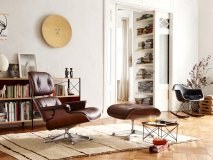
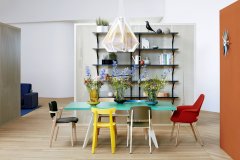
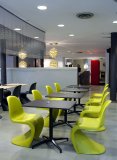
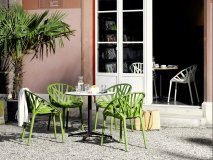
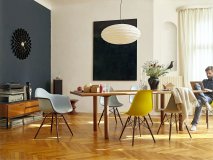
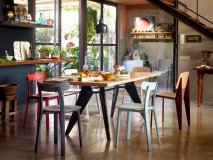
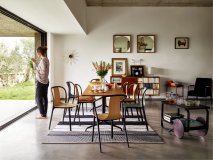
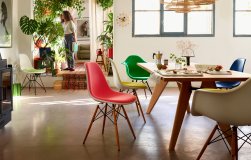
Since the 1950s Vitra has shaped living and working environments around the world with its chairs. Whether iconic classics or contemporary chair designs the Swiss manufacturer combines formal clarity, ergonomics and technical innovation at the highest level. Today Vitra offers solutions for a wide variety of applications: from home offices to restaurants and educational institutions. Here we introduce some of the most important design milestones, present key models and demonstrate the versatility of Vitra chairs.
Since its founding the history of the furniture manufacturer Vitra has been inextricably linked to seating design. When Vitra founders Erika and Willi Fehlbaum discovered chairs by Ray and Charles Eames in New York in the early 1950s they decided to produce and market the Eames designs in Europe; and having secured a license from US manufacturer Herman Miller, began production in 1957, making the Eames' chairs among the Swiss manufacturer's first furniture designs. With collections such as the Eames Plastic Chairs or the Eames Aluminium and Soft Pad Chairs, Vitra not only delivered technically innovative processing techniques and material solutions, but also combined these with functional properties and ergonomic design.
Thanks to decades of experience and in-depth expertise Vitra has repeatedly written contemporary design history with its dining room and office chairs and influenced generations of subsequent designers. Design classics such as the Wiggle Side Chair by architect Frank Gehry repeatedly set new standards in aesthetic and technical terms. In addition to designs by design legends such as Jean Prouvé, Charles and Ray Eames and Verner Panton, Vitra is also at the forefront of contemporary designer chairs: Vitra Dining Chairs, such as those in Jasper Morrison's HAL collection, create a contemporary blend of material, form and functionality, thus enjoying international demand and finding use in a wide variety of settings. Below we present contemporary Vitra chairs and those from the most important design eras, and provide an overview of where and for what purposes Vitra chairs are used.
From functionalist beginnings to sustainable innovations, the history of Vitra chairs is a fascinating journey through the design history of the 20th and 21st centuries. This unique "hit parade" highlights influential models and the revolutionary ideas behind them.
1930s/40s: Engineering in Steel and Wood:
The iconic chair designs of the "master of construction" Jean Prouvé are characterised by functionalist design based on industrial precision and material integrity – a prime example of this is his "Standard Chair" from 1934: The statically loaded rear legs made of sheet steel intelligently complement the slimmer front legs, while the wooden seat and backrest add a natural accent. Vitra has been producing the chair since the 2000s, thus focusing on lasting values rather than short-lived trends.
1950s/60s: The Plastics Revolution and Organic Forms
After World War II Charles and Ray Eames revolutionised furniture production with the "Eames Plastic Chair" (from 1950): They employed fibreglass, later replaced by polypropylene, to enable complex, organic shapes in series production, thus creating one of the first industrially manufactured plastic chairs. The variety of seat shells and colours, combined with various bases, make the Eames Plastic Chair a flexible and affordable chair design that has retained its relevance to this day and underscores Vitra's innovative spirit in the use of new materials.
1970s/80s: A Bold Approach to Colour and Monoliths
In the 1970s and 1980s Vitra broke with conventions. Verner Panton's "Panton Chair" (1967, ready for series production in 1999 with Vitra) is an iconic example of this era. As the first cantilever chair made from a single piece of polyurethane it embodied a futuristic vision of furniture design. Its sculptural form and vibrant colours reflected the spirit of the times and demonstrated Vitra's willingness to push technological boundaries and provide a platform for expressive designs.
1990s/2000s: Reduction to the essentials and subtle innovation
The turn of the millennium brought a return to functional clarity and ergonomic refinement. Maarten Van Severen's ".03 Chair" (1998) exemplifies this approach. Its minimalist silhouette conceals an intelligent construction, in which flexible polyurethane on an aluminum frame enables a dynamic and comfortable seating experience. This chair exemplifies Vitra's commitment to subtle innovations that harmonise form and function.
Today: Sustainability as a Design Principle and Circular Concepts
Current Vitra developments increasingly focus on sustainability and the integration of ecological aspects into the design process. The "Tip Ton" chair by Edward Barber & Jay Osgerby (2011) is a striking example. Made from recyclable polypropylene, its innovative geometry allows for a forward tilt of the pelvis, promoting a more ergonomic and active sitting posture. This demonstrates Vitra's commitment to combining design with ecological responsibility and a contemporary understanding of seating comfort.
Timeless design, outstanding ergonomics, the highest quality and sophisticated functionality – these are the key advantages that distinguish Vitra chairs. Whether for productive work in offices and law firms, relaxed relaxation in private living spaces, flexible solutions for educational institutions and event centres, or stylish accents in restaurants, hotels, medical practices, lobbies and retail outlets: Vitra offers the optimal seating solution for every need and every environment. The following overview is intended to make your selection easier by structuring the diverse possible uses based on typical environments and providing a concise example for each:
► Ergonomic office chairs: For long, healthy sitting periods in offices, agencies, and law firms. Models like the ID Mesh offer individual adjustment options and dynamic support.
► Aesthetic office chairs: For design enthusiasts who value not only ergonomics but also a certain aesthetic in their home office. Attractive models include the Mynt Chair by Erwan Bouroullec or the design classic Eames Aluminium Chair - for design fans who value not only ergonomics but also an attractive appearance in their home office.
► Visitor chairs: Representative and comfortable seating for waiting areas in medical practices, law firms, and shops, e.g., the elegant Eames Side Chair DSW
► Conference chairs: Functional and often stackable chairs that make even longer meetings pleasant, ideal for meeting rooms in companies and organisations, such as the versatile HAL Ply Tube
► Dining room chairs: Comfortable and stylish chairs for the private dining area that combine design and comfort, e.g., the Vitra Mikado Side Chair by Edward Barber & Jay Osgerby
► Living room chairs & armchairs: Design highlights and comfortable seating for relaxing in the living area, such as the iconic Eames Lounge Chair & Ottoman.
► Rocking chairs: Iconic designs like the Eames RAR, which invite you to linger and add a special touch to living rooms or lobbies.
► Stools: Flexible seating and practical additions for various living areas or as temporary seating in stores, such as the stools from the Cork Family
► Training Chairs: Robust, stackable chairs for schools, universities, and continuing education institutions, such as the Eames Plastic Side Chair DSS, or the multifunctional stool Stool-Tool for workshops
► Event Chairs: Flexible and easy-to-store chairs, such as the stackable HAL Ply Tube, that quickly adapt to different room configurations in event centres and multi-purpose halls
► Children's Chairs: Ergonomic and durable chairs for kindergartens, elementary schools, and play areas that promote healthy sitting posture, e.g., the colourful Panton Junior
► Café & Restaurant Chairs: Stylish and durable chairs that create atmosphere and offer guests comfort, such as the elegant yet robust and stackable Belleville Chair Outdoor, which is perfect for cafés, restaurants, and bistros.
► Waiting Area Seating: Comfortable and design-oriented seating solutions for airports, doctor's offices, hospitals, and museums, such as the Moca Chair.
► Lobby Seating: Prestigious and inviting seating for hotel and corporate lobbies, such as the DCW lounge chair.
► Garden & patio chairs: Weatherproof and stylish chairs like the Landi Chair, which stylishly complement the outdoor areas of restaurants, cafés, hotels, and private gardens.
► Outdoor-suitable chairs that can be used indoors and outdoors, such as the lounge chair Eames Plastic Side Chair RE LSR
Choosing the perfect Vitra chair is often easier when you can try it out in person. In our smow stores you have the opportunity to try out different models, see colour variations in person and experience the quality of workmanship for yourself. We look forward to advising you on suitable combinations for your interior. Or are you planning a larger project? We will work with you to develop customised solutions for offices or public spaces: our interior design, architecture, and planning experts at smow works will support your project from conception to implementation.
...Whether at Vitra, Hem Frama, or &Tradition – the patterns gave minimalism a subtle, skillful break...
...W1, Wegneritis is a condition exclusive to furniture designers first recorded in Denmark where Jørgensen Wegner, a Hans by birth, and a leading carpenter of his age whose chairs were celebrated and acclaimed throughout all the known lands of that period, was beset by a compulsion, a creative itch, to design ever new chairs, "If only you could design just one good chair in your life", he would respond to anyone who questioned his phenomenal and relentless prolificness, for all in context of the universally agreed high-quality of his designs, "but you simply cannot", he would bewail loudly as he returned to his studio to begin the next project... The best recorded and most intensively studied expressions of Wegneritis beyond that of the Hans Jørgensen Wegner include, for example, that of the Babelsberger Eiermann by the name of Egon who over many decades sought to design "der Stuhl seines lebens", 'the chair of his life', a searching, an itch, that saw him regularly switch between materials and contexts, and a "Stuhl seines lebens" near all objective observers agree he regularly achieved, designing excellent chairs for innumerable lives; or the Grcic Konstantin who despite having realised at the start of his furniture design journey a Kite that was also a chair, and which in the opinion of many wise sages represented a near perfect definition of a chair, came closer than arguably anyone ever has come, or ever will come, to the immaterial archetype from which Plato speaks, continually produced ever new works from ever new conceptual perspectives and technical approaches...
...the, then, Director of the Industrial Design Department at the Museum of Modern Art, New York, reflected, not uncritically, that "as more and more new chairs become available to the buying public, the problem of selection begins to be bewildering... "1 Just one of a great many questions of chairs, seats, sitting and sitters A Chair and You at the Grassi Museum für Angewandte Kunst, Leipzig, encourages, empowers, you to reflect upon...
...1 The exhibition Tsuyoshi Tane: The Garden House in the Vitra Design Museum Gallery, and the eponymous Garden House by Tsuyoshi Tane, the latest addition to the Vitra Campus in Weil am Rhein, allow one to approach not only a better appreciation of Tane's positions but also to experience how they influence and inform his approach, his works, his architecture... For all that Vitra is popularly associated with Weil am Rhein, Germany, the company's origins are to be found just across the border in Switzerland, specifically in Birsfelden on the edge of Basel, the association with Weil am Rhein being first forged in the early 1950s, a period when Vitra was still, primarily, a shop-fitting company, if one taking its first, tentative, steps into domestic interiors alongside retail interiors...
...Diaries which contain some of the most complete and detailed descriptions of Swiss society, and in which one also finds the earliest descriptions of the earliest (hi)story of the contemporary Switzerland, a, as Heidi records, nation constituted from a loosely bound collective, a cantonation, of ancient peoples, including, and amongst many, many others, the Röthlisberger, the Horgenglarus, the Usm, the Wohnbedarf, the Embru, or the Vitronians whose contemporary Commonwealth of Vitra was initially established across a number of fields on the banks of the river Birs in the north-western corner of the Toblerone cordillera... Yet it was, inarguably, the Vitronians, for all under the leadership of the benevolent Fehlbaum der Jüngere, who were the most active in terms of international exchange; not only cooperating with an American Miller by the name of Herman to introduce works and positions by the likes of, for example, Eames Office, I Samunoguchi, George Nel-son or Alexander Gi Rard into Switzerland, but also expanding the Commonwealth of Vitra to the neighbouring regions of Germany and from where they introduced the furniture of the American Miller Herman to the many peoples of Europe...
...According to Hauke Wendler the origins of the Monobloc project can be traced back to a photo he saw in a newspaper in February 2013; a photo from Yemen of a man walking through a forest of poorly ordered monobloc chairs in an otherwise deserted desert landscape; a photo which Wendler describes as "a beautiful photo full of questions and secrets and at the same time an incredible accumulation of plastic waste"... For all that the monobloc chair is today popularly associated with cheap, insubstantial objects2, an "accumulation of plastic waste" in the making, the (hi)story of the monobloc essentially begins, as Hauke Wendler argues, with Verner Panton's late 1950s eponymous reinforced fibreglass cantilever chair for Vitra, one of the first commercial moulded plastic chairs, before in the mid-1960s with Helmut Bätzner's BA 1171 for Wilhelm Bofinger and Vico Magistretti's Selene for Artemide, both formed from fibreglass reinforced polyester, both stackable, both formally reduced, both crafted from a minimum of material, both employing folds and curves to maximise stability, one very clearly joins the path to that which we today call the monobloc...
...If a presentation that for all the scope it has, could be a lot wider, Dieckmann's interior design, for example, comes far, far, too short: yes, the exhibition title specifies Chairs, but a great many of Dieckmann's chairs were designed for interiors, and in Dieckmann's oeuvre interior design was not only a large component, but an important component in the development of his positions to and understandings of not just seating, but relationships to furniture... Similarly his Typenmöbel, his programme furntiture12, comes far, far too short: yes, the exhibition title specifies Chairs, but his Typenmöbel programme with its reduced, rational, open form, its frugal use of material while maintaining a richness of character and the prediction of palette furniture clearly readable in many of the chairs, was, arguably, more democratic, less about furniture as being representative of status and more about utility, than others had achieved by the mid-1920s, and Typenmöbel that can thus tell us a lot about Dieckmann...